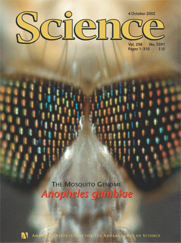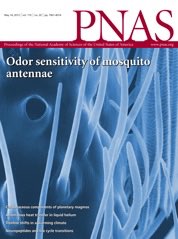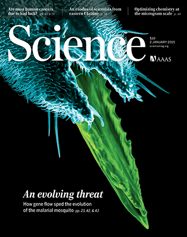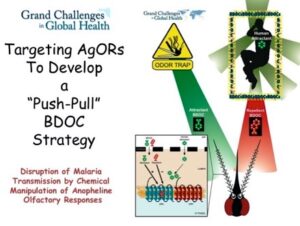For more information on the Grand Challenges Program of the Bill and Melinda Gates Foundation and the Foundation for the NIH, go to:
Grand Challenges in Global Heath
From 2005-2014 the Zwiebel Lab was privileged to lead a broad international network of five laboratories (encompassing Yale University, New Haven, CT; Wageningen University, The Netherlands; ICIPE, Kenya; The MRC Laboratories, The Gambia) that has been selected for a $11M Grand Challenge In Global Health grant for the specific purpose to target odorant receptors in order to design a new generation of mosquito repellents and attractants.
Together with colleagues at the Vanderbilt Institute for Chemical Biology we used state of the art molecular and chemical approaches that target AgOR/AaORs in order to design a new generation of mosquito repellents and attractants that would foster the design of novel programs that target chemosensory pathways and the behaviors they control in vector mosquitoes. These also include behavioral disruption programs based on specific inhibitors (aka “confusants”) of OR-mediated olfactory pathways as well as the identification and intelligent design of novel and economically synthesized mosquito attractants and repellents. This approach has been extended to other mosquito vectors as well where reductions in host seeking (through the use of confusants or repellants) could potentially effect disease transmission by targeting adult vectorial capacity. Attractants may be incorporated into novel mosquito management strategies, these include: lures to increase the efficiency of traps for sentinel monitoring of vector populations and insecticide-laden mosquito trapping systems for population reduction; augmentation of insecticide-treated net (ITN)-based strategies as well as otherwise enabling innovative insect/disease control strategies that focus on disrupting and/or taking advantage of vector-host interactions.
http://www.grandchallenges.org/Pages/Default.aspx
http://www.fnih.org/work/key-initiatives/grand-challenges-global-health
http://www.grandchallenges.org/ControlInsect/Challenges/ChemicalStrategy/Pages/default.aspx
http://www.fnih.org/work/key-initiatives/vector-based-control-transmission-discovery-research-vctr
Our GCGH project collectively produced over 60 scientific publications!
2006
Van der Goes van Naters, W. and Carlson, J. (2006) Insects as chemosensors of humans and crops, Nature 444, 302-307. http://www.ncbi.nlm.nih.gov/pubmed/17108954?ordinalpos=52&itool=EntrezSystem2.PEntrez.Pubmed.Pubmed_ResultsPanel.Pubmed_DefaultReportPanel.Pubmed_RVDocSum
2007
Odor Coding in the Maxillary Palp of the Malaria Vector Mosquito Anopheles gambiae. T. Lu*, G. Wang*, YT. Qiu,* J.Y. Young*, M. Rutzler, H.W. Kwon, R. J. Pitts, J. J.A. van Loon, J. R. Carlson, W. Takken, and L. J. Zwiebel. Current Biology (2007) Sept. 18; 17(18): 1533-1544. Epub 2007 Aug 30.
Attractiveness of MM-X traps baited with human or synthetic odor to mosquitoes (Diptera: Culicidae) in The Gambia. Qiu, Y-T., Smallegange, R.C., ter Braak, C.J.F., Spitzen, J, van Loon, J.J.A., Jawara, M., Milligan, P., Galimard, A.M., van Beek, T.A., Knols, B.G.J. & Takken, W. (2007) The Journal of Medical Entomology 44, 970-983.
2008
The Molecular and Cellular Basis of Olfactory Behavior in Anopheles gambiae Larvae. Yuanfeng Xia*, Guirong Wang*, Daniela Buscariollo, R. Jason Pitts, Heidi Wegner and L. J. Zwiebel. Proceedings of the National Academy of Sciences, (2008) Apr 29;105(17):6433-8. Epub 2008 Apr 21 http://www.ncbi.nlm.nih.gov/pubmed/18427108?ordinalpos=1&itool=EntrezSystem2.PEntrez.Pubmed.Pubmed_ResultsPanel.Pubmed_RVDocSum
3-D flight behaviour of the malaria mosquito Anopheles gambiae s.s. inside an odour plume. Beeuwkes, J., Spitzen, J., Spoor, C.W., van Leeuwen, J.L. & Takken, W. (2008) Proceedings of Experimental and Applied Entomology, N.E.V., Amsterdam 19,137-146 http://www.ent.wur.nl/UK/Publications/
Structural design affects entry response of mosquitoes in olfactometers. Verhulst, N.O., Takken, W. & Smallegange, R.C. (2008) Proceedings of Experimental and Applied Entomology, N.E.V., Amsterdam 19, 129-136. http://www.ent.wur.nl/UK/Publications/
Effect of human odours and positioning of CO2 release point on trap catches of the malaria mosquito Anopheles gambiae s.s. in an olfactometer. Spitzen, J., Smallegange, R.C. & Takken, W. (2008) Physiological Entomology 33, 116-122. http://www.ent.wur.nl/UK/Publications/
Establishment of a large semi-field system for experimental study of African malaria vector ecology and control in Tanzania. Ferguson HM, Ng’habi KR, Walder T, Kadungula D, Moore SJ, Lyimo I, Russell TL, Urassa H, Mshinda H, Killeen GF, Knols BG. Malaria J. 2008 Aug 20;7(1):158 http://www.ncbi.nlm.nih.gov/pubmed/18715508?ordinalpos=25&itool=EntrezSystem2.PEntrez.Pubmed.Pubmed_ResultsPanel.Pubmed_DefaultReportPanel.Pubmed_RVDocSum
3-D flight behaviour of the malaria mosquito Anopheles gambiae s.s. inside an odour plume. Beeuwkes, J., Spitzen, J., Spoor, C.W., van Leeuwen, J.L. & Takken, W. (2008) Proceedings of Experimental and Applied Entomology, N.E.V., Amsterdam 19,137-146. http://www.ent.wur.nl/UK/Publications/
Evaluation of two counterflow traps for testing behaviour-mediating compounds for the malaria vector Anopheles gambiae s.s. under semi-field conditions in Tanzania. Schmied, W.H., Takken, W., Killeen, G.F., Knols, B.G.J. & Smallegange, R.C. (2008) Malaria Journal 7:230 DOI:10.1186/1475-2875-7-23 http://www.ncbi.nlm.nih.gov/pubmed/18980669?itool=EntrezSystem2.PEntrez.Pubmed.Pubmed_ResultsPanel.Pubmed_RVDocSum&ordinalpos=11
Structural design affects entry response of mosquitoes in olfactometers. Verhulst, N.O., Takken, W. & Smallegange, R.C. (2008). Proceedings of Experimental and Applied Entomology, N.E.V., Amsterdam 19, 129-136. http://www.ent.wur.nl/UK/Publications/
The suitability of clay pots for indoor sampling of mosquitoes in an arid area in northern Tanzania. Bijllaardt, W. van den, Braak, R. ter, Shekalaghe, S., Otieno, S., Mahande, A., Sauerwein, R., Takken, W. & Bousema, T. Acta Tropica 111, 197-199. doi:10.1016/j.actatropica.2009.04.003
2009
Limitation of using synthetic human odors to test mosquito repellents. Okumu, F., Titua, E., Mbeleyela, E., Killeen, G. & Moore, S. Malaria J. 2009 Jul 7;8:150. http://www.ncbi.nlm.nih.gov/pubmed/19583848?itool=EntrezSystem2.PEntrez.Pubmed.Pubmed_ResultsPanel.Pubmed_RVDocSum&ordinalpos=2
Optimising odour baited trap methods for collecting mosquitoes during the malaria season in The Gambia. Jawara, M., Smallegange, R.C., Jeffries, D., Nwakanma, D.C., Awolola, S., Knols, B.G.J., Takken, W. & Conway, D.J. PLoS One 4:e8167. http://www.ncbi.nlm.nih.gov/pubmed/19997640?itool=EntrezSystem2.PEntrez.Pubmed.Pubmed_ResultsPanel.Pubmed_RVDocSum&ordinalpos=2
Cultured skin microbiota attracts malaria mosquitoes. Verhulst, N., Beijleveld, H., Knols, B.G.J., Takken, W., Schraa, G., Bouwmeester, H.J. & Smallegange, R.C. Malaria Journal Dec.17 ;8(1):302 http://www.ncbi.nlm.nih.gov/pubmed/20017925?itool=EntrezSystem2.PEntrez.Pubmed.Pubmed_ResultsPanel.Pubmed_RVDocSum&ordinalpos=2
The effect of aliphatic carboxylic acids on olfaction-based host seeking of the malaria mosquito Anopheles gambiae sensu stricto (Diptera: Culicidae). Smallegange, R.C., Qiu, Y.T., Bukovinszkiné Kiss, G., Van Loon, J.J.A. & Takken, W. J Chem Ecol. 2009 Aug;35(8):933-43. Epub 2009 Jul 23 http://www.ncbi.nlm.nih.gov/pubmed/19626371?itool=EntrezSystem2.PEntrez.Pubmed.Pubmed_ResultsPanel.Pubmed_RVDocSum&ordinalpos=5
Olfactory perception: receptors, cells, and circuits.
Su, CY, Menuz, K, Carlson JR Cell 2009 Oct 2;139(1):45-59. http://www.ncbi.nlm.nih.gov/pubmed/19804753?itool=EntrezSystem2.PEntrez.Pubmed.Pubmed_ResultsPanel.Pubmed_RVDocSum&ordinalpos=2
Effectiveness of synthetic versus natural human volatiles as attractants for the malaria mosquito Anopheles gambiae Giles sensu stricto. Smallegange, R.C., Knols, B.G.J. & Takken, W. Journal of Medical Entomology 47 (3) 329-337. http://esa.publisher.ingentaconnect.com/content/esa/jme/2010/00000047/00000003/art00007
Olfactory physiology of blood-feeding vector mosquitoes. Qiu, Y.T. & van Loon, J.J.A. In: Takken W & Knols BGJ (ed.) Ecology and Control of Vector-Borne Diseases. Vol. II. www.WageningenAcademic.com/ecvd-01
Host-seeking behaviour of mosquitoes: responses to olfactory stimuli in the laboratory. Smallegange, R.C. & Takken, W. In: Olfaction in Vector-Host Interactions. Ecology and control of vector-borne diseases Vol. 2. Takken, W. & Knols, B.G.J., eds. Wageningen Academic Publishers, Wageningen, The Netherlands, pp. 143-180.
www.WageningenAcademic.com/ecvd-01
Using nylon strips to dispense mosquito attractants for sampling the malaria vector Anopheles gambiae. Okumu, F., Biswaro, L., Mbeleyela, E., Killeen, G., Mukabana, R., & Moore, S. J. Med. Entomology 47(2): 274-82. http://www.ncbi.nlm.nih.gov/pubmed/20380310
Development and field evaluation of a synthetic mosquito lure that are more attractive than humans. Okumu, F.O., Killeen, G.F., Ogoma, S., Biswaro, L., Smallegange, R.C., Mbeleyela, E., Titus, E., Munk, C., Ngonyani, H., Takken, W., Mshinda, H., Mukbana, W.R., & Moore, S.J. PLoS One 5(1): e8951. http://www.plosone.org/article/info%3Adoi%2F10.1371%2Fjournal.pone.0008951
3-D tracking of flying Anopheles gambiae s.s. malaria mosquitoes in response to human odours and heat. Spitzen, J., Spoor, K.W., Grieco, F., Beeuwkes, J., Kranenbarg, W., Van Leeuwen., J.L., Noldus, L.P.J.J., Van Brugge, S.P. & Takken, W. Journal of Experimental Biology
Anopheles gambiae TRPA1 is a heat activated channel expressed in thermosensitive sensilla of female antennae. Guirong Wang*, Yu Tong Qiu, Tan Lu, HW Kwon, R. Jason Pitts, Joop J.A. van Loon, Willem Takken and L. J. Zwiebel. European Journal of Neuroscience. 2009 Sep;30(6):967-74. Epub 2009 Sep 4. http://www.ncbi.nlm.nih.gov/pubmed/19735290
2010
Host-seeking behaviour of Afrotropical Anophelines: field and semi-field studies. Mukabana, W.R., Olanga, E.A. & Knols, B.G.J. (2010) In: Olfaction in Vector-Host Interactions. Ecology and control of vector-borne diseases Vol. 2. Takken, W. & Knols, B.G.J., eds. Wageningen Academic Publishers, Wageningen, The Netherlands, pp. 181-202. doi: 10.3920/978-90-8686-698-4
Chemical ecology of interactions between human skin microbiota and mosquitoes (2010) Verhulst, N.O., Takken, W., Dicke, M., Schraa, G. & Smallegange, R.C. FEMS Microbiology Ecology 74: 1-9. doi:10.1111/j.1574-6941.2010.00908.x
Molecular Regulation of Olfaction in Mosquitoes. J. Bohbot, T. Lu and LJ Zwiebel. In: Olfaction in Vector-Host Interactions. Ecology and control of vector-borne diseases Vol. 2. Takken, W. & Knols, B.G.J., eds. Wageningen Academic Publishers, Wageningen, The Netherlands, pp. 17-38. doi: 10.3920/978-90-8686-698-4
Odourant reception in the malaria mosquito Anopheles gambiae. Allison Carey, Guirong Wang, Chih-Ying Su, Laurence J. Zwiebel, and John R. Carlson. (2010) Nature 464, 66-71. http://www.ncbi.nlm.nih.gov/pubmed/20130575
Attraction of Anopheles gambiae to odour baits augmented with heat and Moisture. Olanga, E.A., Okal, M.N., Mbadi, P.A., Kokwaro, E.D. and W.R. Mukabana, 2010, Malaria Journal. http://www.ncbi.nlm.nih.gov/pubmed/20051143?itool=EntrezSystem2.PEntrez.Pubmed.Pubmed_ResultsPanel.Pubmed_RVDocSum&ordinalpos=1
The Molecular Basis of Odor Coding in the Malaria Vector Mosquito Anopheles gambiae. Guirong Wang, Allison Carey, John R. Carlson and Laurence J. Zwiebel (2010) Proceedings of the National Academy of Sciences USA. 2;107(9):4418-23. Epub 2010 Feb 16. http://www.ncbi.nlm.nih.gov/pubmed/20160092
Scent of a Human, J. Carlson and A. Carey, Scientific American, 305, 76-79.Also appeared as: Der Duft der Menschen, Spektrum der Wissenschaft, 34-38.; Le Moustique, expert en odeur humaine, Pour la Science; El olfato de los mosquitos, Investigacion y Ciencia, 68-71. http://www.ncbi.nlm.nih.gov/pubmed/21717963
Differential Attraction of Malaria Mosquitoes to Volatile Blends Produced by Human Skin Bacteria. Verhulst, N.O., Andriessen, R., Groenhagen, U., Bukovinszkiné Kiss, G., Schulz, S., Takken, W., Van Loon, J.J.A., Schraa, G., & Smallegange, R.C. (2010) PLoS One 5(12): e15829. http://www.ncbi.nlm.nih.gov/pubmed/21209854
Distinct Olfactory Signaling Mechanisms in the Malaria Vector Mosquito Anopheles gambiae. Chao Liu*, R. Jason Pitts*, Jonathan D. Bohbot, Patrick L. Jones, Guirong Wang and Laurence J. Zwiebel. PLoS Biology, (2010) 8(8): e1000467 doi:10.1371/ journal.pbio.1000467. http://www.ncbi.nlm.nih.gov/pubmed/20824161
2011
Temporal coding of odor mixtures in an olfactory receptor neuron. Su, C.-Y., Martelli, C., Emonet, T. and J. Carlson (2011), PNAS 108, 5075-5080. http://www.ncbi.nlm.nih.gov/pubmed/21383179
Conservation of Indole Responsive Odorant Receptors in Mosquitoes Reveals an Ancient Olfactory Trait. Jonathan D. Bohbot*, Patrick L. Jones*, Guirong Wang*, R. Jason Pitts, Gregory M. Pask and Laurence J. Zwiebel. Chemical Senses (2011) Jan; 36(2):149-60. Epub 2010 Oct 18. http://www.ncbi.nlm.nih.gov/pubmed/20956733
A Research Agenda for Malaria Eradication: Vector Control. The MalERA Consultative Group on Vector Control Alonso PL, Besansky NJ, Burkot TR, Collins FH, Hemingway J, James AA, Lengeler C, Lindsay S, Liu Q, Lobo NF, Mnzava A, Tanner M, Zwiebel LJ. PLoS Medicine (2011) 8(1): e1000401 doi:10.1371/ journal.pmed.100041. http://www.ncbi.nlm.nih.gov/pubmed/21311587
Functional Agonism of Insect Odorant Receptor Ion Channels. Patrick L. Jones, Gregory M. Pask, David Rinker and Laurence J. Zwiebel. Proceedings of the National Academy of Sciences USA, PNAS 2011; published ahead of print May 9, 2011, doi:10.1073/pnas.1102425108. http://www.ncbi.nlm.nih.gov/pubmed/21555561
Improvement of a synthetic mosquito lure using compounds produced by human skin bacteria. Verhulst, N.O., Mbadi, P.A., Bukovinszkiné Kiss, G., Mukabana, W.R., Van Loon, J.J.A., Takken, W. & Smallegange, R.C. (2011) Malaria Journal 10:28. http://www.ncbi.nlm.nih.gov/pubmed/213034
Behavioural responses of Anopheles gambiae sensu stricto to components of human breath, sweat and urine depend on mixture composition and concentration. Qiu, YT, Smallegange, R.C., van Loon, JJA & Takken, W. (2011) Medical and Veterinary Entomology 25: 247-255. http://www.ncbi.nlm.nih.gov/pubmed/21108650
Human skin microbiota and their volatiles as odour baits for the malaria mosquito Anopheles gambiae s.s.. Verhulst, N.O., Mukabana, W.R., Takken, W. & Smallegange, R.C. (2011) Entomologia Experimentalis et Applicata 139: 170-179. doi: 10.1111/j.1570-7458.2011.01119.x
Sweaty skin: an invitation to bite? (2011) Smallegange, R.C., Verhulst, N.O. & Takken, W. Trends in Parasitology 27: 143-148. http://www.ncbi.nlm.nih.gov/pubmed/21256083
Heteromeric Anopheline Odorant Receptors Exhibit Distinct Channel Properties. Gregory M. Pask, Patrick L. Jones, Michael Rützler, David Rinker and Laurence J. Zwiebel. PLoS ONE (2011) 6(12): e28774. doi:10.1371/journal.pone.0028774. http://www.plosone.org/article/info%3Adoi%2F10.1371%2Fjournal.pone.0028774
2012
Novel high-throughput screens of Anopheles gambiae odourant receptors reveal candidate behaviour-modifying chemicals for mosquitoes. David C. Rinker, Patrick l. Jones, R. Jason Pitts, Michael Rützler, J. Gray Camp, Lujuan Sun, Pingxi Xu, David Weaver and Laurence J. Zwiebel, Physiological Entomology (2012) 37, 33-41. http://onlinelibrary.wiley.com/doi/10.1111/j.1365-3032.2011.00821.x/abstract
Allosteric Antagonism of Insect Odorant Receptor Ion Channels. Patrick L. Jones, Gregory M. Pask, Ian M. Romaine, Robert W. Taylor, Paul R. Reid, Alex G. Waterson, Gary A. Sulikowski and Laurence J. Zwiebel, PLoS ONE (2012) 7(1): e30304. doi:10.1371/ journal.pone.0030304. http://www.plosone.org/article/info%3Adoi%2F10.1371%2Fjournal.pone.0030304
Insect olfaction from model systems to disease control, Carey, A. and Carlson, J. Proc. Natl. Acad. Sci USA 108, 12987-12995.http://www.ncbi.nlm.nih.gov/pubmed/21746926
Chemoreception: Identifying friends and foes Koh, T.-W. and Carlson, J. Current Biology (2011) 2011 Dec 20;21(24):R998-9.http://www.ncbi.nlm.nih.gov/pubmed/22192835
Composition of Human Skin Microbiota Affects Attractiveness to Malaria Mosquitoes. Verhulst, N.O., Qiu, Y.T., Beijleveld, H., Maliepaard, C., Knigths, D., Schulz, S., Berg-Lyons, D., Lauber, C.L., Verduijn, W., Haasnoot, G.W., Mumm, R., Bouwmeester, H.J., Claas, F.H.J., Dicke, M., van Loon, J.J.A., Takken, W., Knight, R. & Smallegange, R.C. (2011) PLoS One 6: e28991. doi:10.1371/journal.pone.0028991.http://www.plosone.org/article/info%3Adoi%2F10.1371%2Fjournal.pone.0028991
Identification of attractants and inhibitors for behavioural disruption of the malaria mosquito Anopheles gambiae: laboratory and semi-field assays. Smallegange, R.C., Bukovinszkiné-Kiss, G., Otieno, B., Mbadi, P.A., Takken, W., Mukabana, W.R. & van Loon, J.J.A. Physiological Entomology (2012) 37: 60–71. DOI: 10.1111/j.1365-3032.2011.00827.x
Spatial repellents: from discovery and development to evidence-based validation. Nicole L Achee, Michael J Bangs, Robert Farlow, Gerry F Killeen, Steve Lindsay, James G Logan, Sarah J Moore, Mark Rowland, Kevin Sweeney, Steven J Torr, Laurence J. Zwiebel and John P Grieco, Malaria Journal, 2012 May 14;11:164.http://www.ncbi.nlm.nih.gov/pubmed/22583679
Structure-Activity Relationship of a Broad-Spectrum Insect Odorant Receptor Agonist. Robert W. Taylor, Ian M. Romaine, Chao Liu, Poornima Murthi, Patrick L. Jones, Alex G. Waterson, Gary A. Sulikowski and Laurence J. Zwiebel, ACS Chemical Biology 2012 Oct 19;7(10):1647-52. doi: 10.1021/cb300331z. Epub 2012 Aug 27.http://www.ncbi.nlm.nih.gov/pubmed/22924767
The Molecular Receptive Range of an Enantio-selective Lactone Receptor in Anopheles gambiae. Gregory M. Pask, Ian M. Romaine and Laurence J. Zwiebel, Chemical Senses, first published online September 2, 2012 doi:10.1093/chemse/bjs074.http://www.ncbi.nlm.nih.gov/pubmed/22944613
Montague, S., Mathew, D., and Carlson, J. (2011) Similar odorants elicit different behavioral and physiological responses, some super-sustained J. Neuroscience 31, 7891-7899.http://www.ncbi.nlm.nih.gov/pubmed?term=montague%20s%20carlson%20j
Su, C.-Y., Menuz, K., Reiser, J. and Carlson J. Non-synaptic inhibition between grouped neurons in an olfactory circuit, Nature 2012 Nov 21. doi: 10.1038/nature11712. [Epub ahead of print] http://www.ncbi.nlm.nih.gov/pubmed?term=carlson%20jr%20reisert%20j
Field Testing of Different Chemical Combinations as Odour Baits for Trapping Wild Mosquitoes in The Gambia. Jawara, M., Awolola, T.W., Pinder, M., Jeffries, D., Smallegange, R.C., Takken, W., & Conway, D.J. (2011) PLoS ONE 6(5): e19676. doi:10.1371/journal.pone.0019676. http://www.plosone.org/article/info%3Adoi%2F10.1371%2Fjournal.pone.0019676
A novel synthetic odorant blend for trapping of malaria and other African mosquito species. Mukabana, W.R., Mweresa, C.K., Otieno, B., Omusula, P., Smallegange, R.C., Van Loon, J.J.A. & Takken, W. (2012) Journal of Chemical Ecology 38:235-244. DOI 10.1007/s10886-012-0088-8. http://www.ncbi.nlm.nih.gov/pubmed/22426893
Mosquitoes as potential bridge vectors of malaria parasites from non-human primates to humans. Verhulst, N.O., Smallegange, R.C. & Takken, W. (2012) Frontiers in Physiology 3: 197. doi: 10.3389/fphys.2012.00197. http://www.ncbi.nlm.nih.gov/pubmed/22701434
Evaluation of low density polyethylene and nylon for delivery of synthetic mosquito attractants. Mukabana WR, Mweresa CK, Omusula P, Orindi BO, Smallegange RC, van Loon JJ, Takken W. Parasit Vectors. 2012 Sep 19;5:202. doi: 10.1186/1756-3305-5-202. http://www.ncbi.nlm.nih.gov/pubmed/22992518
2013
Host preferences of blood feeding mosquitoes. Takken, W. & Verhulst, N.O. (2013) Annu. Rev. Entomol. 58:433–53. doi: 10.1146/annurev-ento-120811-153618
Blockade of Insect Odorant Receptors with Amiloride Derivatives. Gregory M. Pask, Yuriy V. Bobkov, Elizabeth A. Corey, Barry W. Ache and Laurence J. Zwiebel, Chemical Senses. http://www.ncbi.nlm.nih.gov/pubmed/23292750
Blood meal-induced changes to antennal transcriptome profiles reveal shifts in odor sensitivities in Anopheles gambiae. Rinker DC, Pitts RJ, Zhou X, Suh E, Rokas A, Zwiebel LJ. Proc Natl Acad Sci U S A.
Malaria-infected mosquitoes express enhanced attraction to human odor. PLoS ONE 8(5): e63602. Smallegange RC, van Gemert GJ, van de Vegte-Bolmer M, Gezan S, Takken W, Sauerwein RW, Logan JG (2013). http://www.ncbi.nlm.nih.gov/pubmed/23691073
2014
Odorant Receptor-Mediated Sperm Activation in the Malaria Mosquito, Anopheles gambiae. Pitts RJ, Liu C, Zhou X, Malpartida, JC., Zwiebel LJ. Proc Natl Acad Sci U S A (2014) 111 (7) 2566-2571, doi:10.1073/pnas.1322923111, Epub 2014 Feb 3.
A push-pull system to reduce house entry of malaria mosquitoes. Menger DJ1, Otieno B, de Rijk M, Mukabana WR, van Loon JJ, Takken W. Malaria Journal 2014 Mar 27;13:119. doi: 10.1186/1475-2875-13-119.
Molasses as a source of carbon dioxide for attracting the malaria mosquitoes Anopheles gambiae and Anopheles funestus. Collins K Mweresa, Philemon Omusula, Bruno Otieno, Joop JA van Loon, Willem Takken, and Wolfgang R Mukabana. Malaria Journal. 2014; 13: 160. Published online Apr 27, 2014. doi: 10.1186/1475-2875-13-160 PMCID: PMC4020376
Assessing the efficacy of candidate mosquito repellents against the background of an attractive source that mimics a human host. Menger DJ, van Loon JJ, Takken W. Medical and Veterinary Entomology (2014), doi: 10.1111/mve.12061
Narrow SAR in odorant sensing Orco receptor agonists. Romaine IM, Taylor RW, Saidu SP, Kim K, Sulikowski GA, Zwiebel LJ, Waterson AG. Bioorg Med Chem Lett. 2014 Jun 15;24(12):2613-6. doi: 10.1016/j.bmcl.2014.04.081. Epub 2014 Apr 29.
The future of insect repellent discovery and development. Jonathan D. Bohbot, Daniel Strickman and Laurence J. Zwiebel, Outlooks on Pest Management August 2014 25(4): 265-270.



